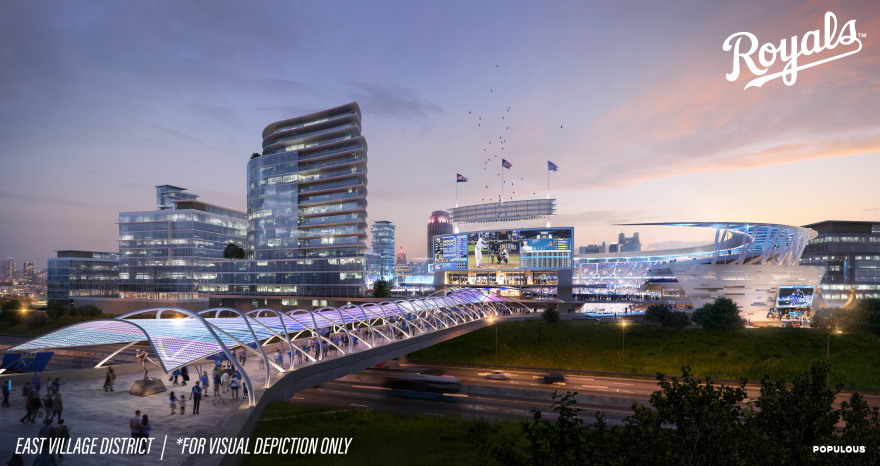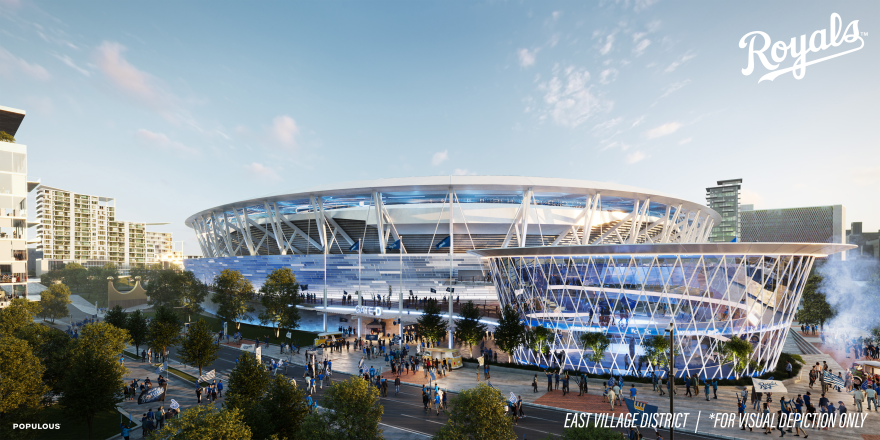The Kansas City Royals unveiled two designs for a ballpark entertainment district on Tuesday, even as the owners have not yet decided exactly where to put it.
The Royals are waffling between two locations for a stadium entertainment district that the team says are “on equal footing”: North Kansas City or the East Village in downtown Kansas City. The team says it plans to pick a location by the end of next month.
The project is expected to cost more than $2 billion, with Royals ownership contributing more than $1 billion toward the cost. It’s still unclear where the additional money will come from, or how much taxpayers will be on the hook for.
The Royals said in a press kit that a new stadium district “will not be possible without public investment.”

Team representatives said the owners are speaking to elected officials in Clay County and Jackson County, including Kansas City Mayor Quinton Lucas.
If the owners choose the East Village, they want to extend the current three-eighths cent Jackson County sales tax currently used to maintain Kauffman Stadium and Arrowhead Stadium. The Royals’ share of the tax funds is estimated at between $300 million and $350 million.
Royals owner John Sherman told The Kansas City Star this week that if the Royals choose the East Village site, the team would want renewal of the three-eighths cent sales tax on the April ballot next year.
It’s currently set to expire in January 2031, the same time the Royals’ lease on Kauffman Stadium is up.

If the Royals choose North Kansas City, the team says it would seek a similar tax. A recent survey conducted by a Washington firm found that 70% of respondents in Clay County were opposed to a sales tax to fund a new ballpark and entertainment district.
Sarah Tourville, Executive Vice President, Chief Commercial and Community Impact Officer for the Royals, said the team was made aware of the poll Tuesday.
“We've assembled a team of local and national experts with sophisticated polling experience,” Tourville said. “That polling data has been very constructive and we see a path to victory in both counties.”
The two sites

A proposed stadium entertainment district in the East Village would cover 27 acres, from 8th Street in the north to 12th Street in the south, and Charlotte Street in the east to Cherry Street in the west.
Team representatives on Tuesday emphasized that the East Village site would focus more on attracting local businesses and restaurants to create an entertainment district that operates year-round.
The stadium will seat 35,000 people. The site rendering includes a pedestrian bridge above the highway to funnel people from Paseo Boulevard to the stadium, a hotel and conference venue and an event plaza.
The team also wants to create a “Cherry Street experience” made up of retail development and local restaurants.
“It's intended to harmonize with the Power and Light district and with the existing downtown developments,” said Earl Santee, global chair and founder of the architecture firm Populous.

The North Kansas City location would be less dense and cover 90 acres, from Armour Road south to 16th Street and I-29 east to Erie Street. That project would include more housing than the East Village site. The project would also include a hotel, a performance venue along Armour Road, retail and a park called North Kansas City Central Park.
“We're trying to create a district by giving it place and giving substance to its development,” Santee said. “It's community focused and the idea is to bring people — a lot of people — into North Kansas City that would love to work and live there.”
The team wants to build new parking structures in either location to supplement existing parking. The proposal in the East Village includes about 4,000 parking spaces.

The Royals claim a new ballpark entertainment district would be an economic boon for the region, predicting the project would create 20,000 jobs and produce $185 million in new regional economic output. But economists agree that sports stadiums don’t bring the long-term benefits to the cities that teams say they will.
The Royals want a new stadium in time to welcome fans on Major League Baseball’s Opening Day in 2028. The team’s current lease at Kauffman Stadium ends in 2031; Sherman and other team representatives said the team would not break its lease.
Community benefits agreement
Team representatives said Tuesday the team is still committed to a community benefits agreement for the new stadium.
The local group Stand Up KC is advocating for an agreement that would raise the wage floor, pay stadium and entertainment workers a living wage and require the team to hire workers from areas hit hardest by unemployment.
“We deserve to have a seat at the table to negotiate a Community Benefits Agreement that ensures poor and working people will have concrete benefits from a generational project like this,’ said Stand Up KC leader and fast food worker Terrence Wise. "Without that, we are being left behind in our own community.”






